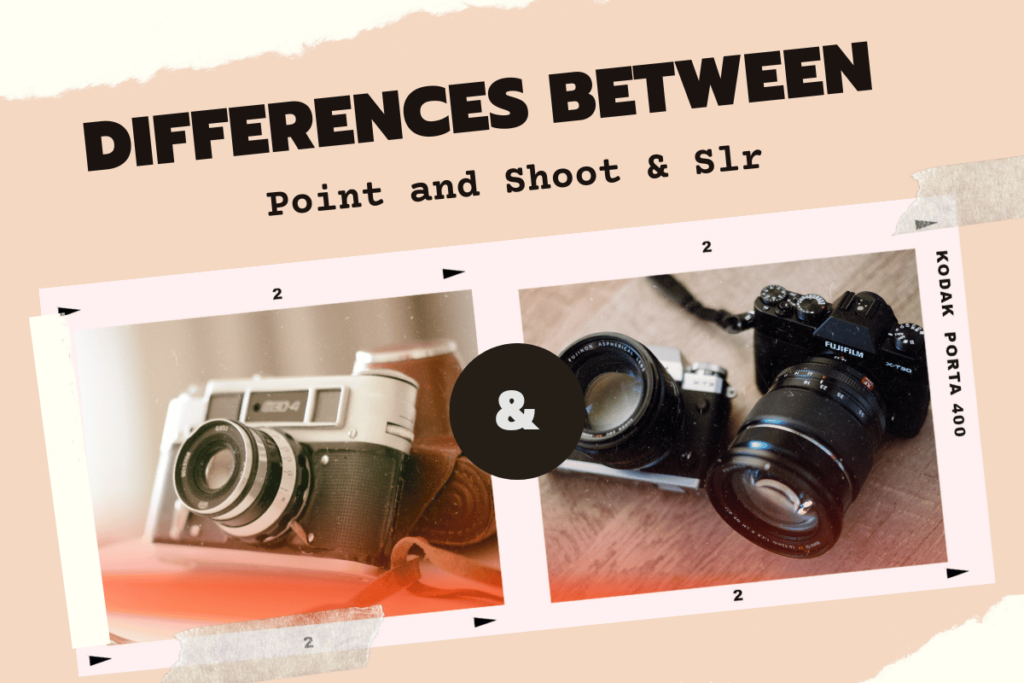
Ever found yourself wondering whether to grab a point and shoot camera or an SLR as you head out the door? You’re not alone. Both have a solid fan base in the photography world, each for good reason.
When exploring how point and shoot cameras differ from SLR cameras, it’s all about balance—weight against control, convenience against quality. But what’s that in actual terms, you ask? Well, let’s break it down:
Point and Shoot Simplicity
Capture life’s spontaneous moments with ease using a point and shoot camera. Known for their portability and simplicity, these gadgets are compact enough to slide into a pocket or purse, ready to document your daily adventures at a moment’s notice. You don’t need to fiddle with complex settings—just aim and capture. Quick to start up and equipped with automated systems, they let you freeze time without missing a beat.
SLR Precision: Control at Your Fingertips
In contrast, an SLR (Single-Lens Reflex) camera is the powerhouse offering you a hands-on, tailored photography experience. It’s like being the conductor of an orchestra—every movement, every decision, is yours to command. With precise manual controls, a heftier body, and interchangeable lenses, an SLR lets you capture more than just images; it captures your vision. From adjusting the focus to manipulating exposure, you’re in the driver’s seat.
Size and Weight
When you’re balancing the need for quality photos with the desire for convenience, size and weight become crucial factors. You’ll notice the difference when you’re on the go, whether you’re touring a city or hiking through nature. Let’s dive into how point and shoot cameras and SLR cameras compare in these aspects.
Compact Convenience
Point and shoot cameras, such as the Canon PowerShot G7 X Mark III, are often the go-to for on-the-move photography enthusiasts. They’re light enough to not weigh you down and small enough to fit in your pocket, literally. Take the PowerShot G7 X Mark III, for example; it tips the scales at a mere 304 grams and boasts dimensions of 105.5 x 60.9 x 41.4 mm.
You might think, what’s the payoff? Well, the lighter build means there’s less to lug around, but it also means these cameras can feel less robust than their larger counterparts. The upside, though, is that you’re always ready to capture that perfect shot without feeling like you’ve been working out at the gym all day.
The SLR Stature
Switching gears, SLR cameras, like the Nikon D3500, pack more bulk due to their intricate mechanics and larger sensors. With measurements of 124 x 97 x 69.5 mm and a weight of 415 grams, the D3500 is certainly heftier. This extra size and weight serve a purpose, providing a stable grip and room for advanced features, which can be pivotal for those perfectly framed, high-quality shots.
Despite the added bulk, many photographers find the heft of an SLR comforting—it signifies durability and the ability to handle more demanding photography sessions. Plus, the larger size accommodates those all-important interchangeable lenses, essential for anything from wide-angle landscapes to zoomed-in wildlife shots.
Balancing Act
So, there you have it. Point and shoot cameras win if you’re looking for something that won’t make your shoulders scream in protest. Yet, SLR cameras might be your ally for more intensive and varied photography needs, even if it means dedicating more of your backpack real estate to your gear. It’s your call, and in photography, as in life, it’s all about finding the balance that works for you.
Lens and Sensor
Breaking down the details of your camera equipment is crucial when capturing that perfect shot. Let’s dive into how point and shoot cameras differ from SLR cameras regarding their lens and sensor specifics.
Compact Convenience: Point and Shoot Cameras
Imagine you’re out exploring a new city. The last thing you want is a bulky camera weighing you down. That’s where point and shoot cameras like the Sony Cyber-shot DSC-RX100 VII shine.
- Fixed lens: With its versatile fixed lens, you’ll find a wide zoom range at your fingertips, allowing you to capture landscapes or zoom in on distant details without switching out any glass.
- Sensor size: Smaller, yes, but packed with enough megapixels to make your Instagram feed pop.
This convenience does come at a cost, though:
- Image Quality: It might not stand up to your professional aspirations under every lighting condition.
- Versatility: You might feel the pinch of limitation when your creativity demands more.
Bold Performer: SLR Cameras
Next up, let’s lay out the features of the SLR camera. Take the Canon EOS Rebel T7i, a favorite among budding photographers. This camera shoulders the promise of superior image quality – and here’s why:
Interchangeable Lenses
- Freedom: Choose from a wide array of lenses for every scenario.
- Quality: Superior optics translate to sharper images even in varied light situations.
Bigger Sensor Means Better Photos
- Sensor size: Larger sensors capture more light and offer better performance, especially in low-light scenarios.
- Resolution: With higher resolutions, cropping and editing become a game of possibilities, not sacrifices.
All this tech comes with considerations:
- Weight: You’re looking at more to carry. That extra lens for the perfect shot? It weighs something.
- Complexity: More features mean more to learn – but think of the power once you’ve mastered it!
What’s Right For You?
You’re in the midst of deciding how point and shoot cameras differ from SLR cameras for your needs. Consider this:
- Are you after uncomplicated, good quality snaps? Point and shoot might be your ticket.
- Or are you diving deep into the world of photography, coveting control over every aspect? Then SLR is calling your name.
Autofocus and Manual Control
Point and Shoot Cameras: Snap Focus
When you’re on the move, the last thing you want is to fumble with settings. That’s where the point and shoot cameras excel, particularly in their autofocus capability. Models like the Panasonic Lumix DC-ZS80 come equipped with a fast and accurate autofocus system. Here’s what this means for you:
- Quick snapping of photos without the lag of focusing.
- User-friendly operations making them ideal for beginners.
But it’s not all roses. The downside is that sometimes you might crave more creative control, which is where point and shoots can fall short. They typically offer less manual control over settings, which could limit your photographic expression.
SLR Cameras: A Tactile Experience
Moving onto SLR cameras, such as the Pentax K-70, we delve into a world where creativity takes center stage. Unlike their point and shoot counterparts, SLR cameras offer a wealth of features for those wanting more artistic control:
- Manual settings that allow precise adjustments in focus.
- The ability to play with depth of field, motion blur, and more.
This level of control, however, comes with a steeper learning curve. You’ll need to wrap your head around various options and settings – but the payoff? Stunning, customized images that reflect your vision.
Here’s a peek at what you’ll get with an SLR in terms of focus control:
| Feature | Description |
|---|---|
| Interchangeable Lenses | Swap lenses for different scenarios, adding versatility. |
| Larger Sensors | Capture more light, enabling superior image quality. |
| Manual Focus | Offers nuanced control over the exact point of focus. |
Let’s talk performance. SLR cameras’ autofocus is often more sophisticated. With options for single-point, dynamic-area, or full-time autofocus, they’ve got you covered from portraits to fast-action shots.
Conclusion
If you are looking for a camera that is easy to use, portable, and versatile, then a point and shoot camera might be a good option for you.If you are looking for a camera that gives you more control, creativity, and performance, then a SLR camera might be a better option for you.
Of course, the best camera for you depends on your budget, style, and goals. You should always try out different cameras before you buy them, and compare their features, functions, and results.
Frequently Asked Questions
What is the main difference between point and shoot cameras and SLR cameras?
Point and shoot cameras are designed for simple operation and portability, while SLR cameras offer more manual control and the ability to change lenses for various photographic needs.
Are point and shoot cameras good for beginners?
Yes, point and shoot cameras are excellent for beginners due to their ease of use and autofocus capabilities which allow for quick photo-taking without needing to adjust settings manually.
Can SLR cameras take better quality images than point and shoot cameras?
SLR cameras generally produce higher quality images thanks to their larger sensors and interchangeable lenses, which provide photographers with a range of artistic options and better low-light performance.
Is it harder to learn how to use an SLR camera?
SLR cameras do have a steeper learning curve due to their advanced features and manual settings, which require some photography knowledge to use effectively.
Do point and shoot cameras offer manual settings like SLR cameras?
Point and shoot cameras may offer some manual settings, but these controls are typically limited compared to the comprehensive manual options available on SLR cameras.

